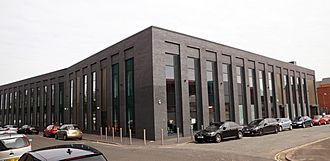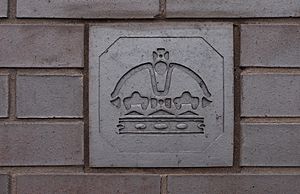Birmingham Assay Office facts for kids
Quick facts for kids Birmingham Assay Office (Since 2015) |
|
|---|---|
 |
|
| General information | |
| Type | Assay Office |
| Address | 1 Moreton Street |
| Town or city | Birmingham |
| Country | England |
| Coordinates | 52°29′11″N 1°55′03″W / 52.4864°N 1.9176°W |
| Completed | 2015 |
| Opened | 27 July 2015 |
The Birmingham Assay Office is a special place in Birmingham, England. It's one of only four assay offices in the United Kingdom. Its job is to test precious metals like silver, gold, and platinum to make sure they are pure. This process is called hallmarking.
Back in the 1700s, Birmingham became famous for making silver items. But there was a problem! All silver items had to be tested at an Assay Office. The closest ones were far away in Chester and London. This made it hard for Birmingham's silversmiths to do business.
A famous inventor named Matthew Boulton and other important business people in Birmingham teamed up with silversmiths from Sheffield. They asked Parliament to create new assay offices in their cities. Even though London silversmiths didn't like the idea, Parliament agreed. In March 1773, a law was passed. This law allowed Birmingham and Sheffield to have their own assay offices.
The Birmingham Assay Office opened on August 31, 1773. It started in just three rooms at the King's Head Inn. Only four people worked there, and it was only open on Tuesdays. Matthew Boulton was their very first customer!
Today, the office is run by 36 "Guardians." These guardians make sure that the standards for testing precious metals are always met. Some of them must be involved in the jewellery trade.
Contents
What is a Hallmark?
A hallmark is a special mark stamped onto items made of precious metals. It tells you that the item has been tested and approved for its purity. It's like a quality guarantee!
The special symbol for the Birmingham Assay Office is the Anchor. The Sheffield Assay Office used to have a Crown as its symbol. There's a fun story about how they chose these symbols. Before the offices opened in 1773, meetings were held at a pub in London called the Crown and Anchor Tavern. It's said they flipped a coin to decide! Birmingham got the Anchor, and Sheffield got the Crown. Sheffield later changed its symbol to the White Rose of York in 1977.
The Assay Office offers many services. They do hallmarking, test for nickel, analyze metals, check how thick plating is, and certify bullion (pure metal bars). They also certify gemstones. You can find more details on their official website.
Where the Office Has Been
The Assay Office has moved several times since it first opened.
- It started in 1773 at the King's Head Inn on New Street.
- In 1782, it moved to Bull Lane.
- Then, in 1799, it moved to Little Colmore Street.
- In 1815, it moved to Little Cannon Street.
The Newhall Street Building (1877-2015)
| Birmingham Assay Office (1877–2015) | |
|---|---|
 |
|
| General information | |
| Type | Assay Office |
| Architectural style | Victorian Italianate |
| Address | Newhall Street |
| Town or city | Birmingham |
| Country | England |
| Coordinates | 52°29′02″N 1°54′22″W / 52.48389°N 1.90611°W |
| Completed | 1877 (Phipson), 1890, 1899, 1907, 1914 (Ewen Harper, architect), 1974 |
| Relocated | 27 July 2015 |
| Owner | TCN UK |
| Design and construction | |
| Architect | Andrew Phipson |
|
Listed Building – Grade II
|
|
| Designated: | 25 September 1972 |
| Reference #: | 1076142 |
Finally, in 1877, the office moved into its own specially built home on Newhall Street. This building was very important. At one point, it was the largest assay office in Europe. In 2003, it hallmarked 13 million items! The Newhall Street building is now a "Grade II listed" building. This means it's a historically important building that needs to be protected.
Moving to a New Home in 2015
By 2015, the Newhall Street building was getting too small. The Assay Office needed more space to do its important work. So, they decided to build a brand new office. A spot on the edge of the Jewellery Quarter was chosen. Construction began in May 2014 and finished in 2015.
The new building cost £10 million to build. It's a two-story building made of special blue bricks. It has modern offices, laboratories for testing, and conference rooms. The Assay Office officially moved into this new building on July 27, 2015.
Special Bricks and Symbols
The new building has some really cool features. It includes special "feature bricks" that show the main hallmarking symbols used over the office's 240-year history. These symbols include:
- A lion for Sterling Silver
- A crown for Gold
- An orb for Platinum
- Pallas Athene for Palladium
- The Birmingham town mark, the anchor, is also shown clearly.
There are also twelve bricks that feature the marks of some of the office's most important customers. These companies gave £12,000 to charity to have their marks included. Some of these companies are Thomas Fattorini, Toye, Kenning & Spencer, and F. Hinds.
The new building also has a private museum called the Silver Collection. Here, you can see many beautiful and historic silver items. The old building on Newhall Street was later turned into "Assay Studios." This is now a creative office space for other businesses.
Images for kids



